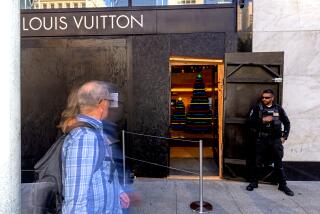Dramatic rise in crime casts a shadow on downtown L.A.’s gentrification
- Share via
As Lauren Mishkind was walking along 7th Street this summer in downtown Los Angeles, a man pulled a handgun and pointed it at another person standing behind her.
Terrified, she hid behind a car while the assailant tackled the victim.
“I was just shaking for the rest of the day,” said Mishkind, who lives downtown and works at an architecture firm in the area. “You kind of assume it’s par for the course living down here, which is kind of more shocking.”
Crime has jumped across the city this year, but nowhere has the increase been as large as in L.A.’s hippest new domain: downtown.
Here, the forces of rapid gentrification are crashing up against the chronic poverty, homelessness and crime that have long been a part of life in the city center. Police and residents say the influx of new lofts, luxury high-rise apartments, bars and eateries have made new downtown dwellers easy targets for street crime.
“Those two communities are rubbing up against each other and for some reason it has gotten more aggressive,” Mishkind said. “We understand there is a grittiness downtown, but that aggression against other people is not acceptable.”
Overall, violent crime in the Los Angeles Police Department’s Central Division, which covers parts of downtown, skid row and Chinatown, was up more than 57% through the end of August compared with the same period last year, and property offenses increased nearly 25%, according to police data.
Certain crimes have captured extra police attention: “Creeper” burglars look for unlocked apartments or cars. Organized crews lift unattended purses or smartphones from tables at cafes. Others prowl around apartments, checking for open windows or doors to sneak inside.
Police say they are working to reverse the trend downtown.
NEWSLETTER: Get the day’s top headlines from Times Editor Davan Maharaj >>
More cops are walking beats through some of the worst-hit areas, such as skid row and the financial district, where officers from the department’s elite Metropolitan Division have recently been deployed. Commanders are tracking data down to the block level to know where and when to send more officers.
But some in downtown question whether these actions are enough to stem the rising tide.
The Rev. Andy Bales, chief executive of the Union Rescue Mission, said he has been disappointed with the LAPD’s response so far. Officers, he said, appear to have largely taken “a hands-off approach” to policing skid row while the homeless population has ballooned and conditions have grown more dire.
Bales said his car has been vandalized several times in the last year as he arrived or left the mission on South San Pedro Street. The problem reminds him of how bad things were more than a decade ago, when crime was rampant in the area.
“You just don’t see the presence of the police as you would think you would in a place that is so desperate, so violent and with so many people at risk and drugs are used openly,” Bales said. “It’s just like Mardi Gras on crack again…. Nobody who doesn’t live it every day would even understand the level of anarchy that’s there.”
LAPD Capt. Don Graham acknowledged the struggles on skid row, which are occurring despite the addition of more officers over the years.
“The police presence … in that area clearly is insufficient for the crime that is going on there,” Graham said.
Many officials say skid row needs the kind of help — more housing and other social services — that police cannot provide.
In more upscale parts of downtown such as Bunker Hill and Little Tokyo, the situation is not as grim. But authorities say crime patterns have a way of spreading from rough areas to the edges of more prosperous ones.
The busy stretch of 5th Street between skid row and Pershing Square is a pipeline for drug dealers and people looking to score.
Merchandise is frequently stolen from the shelves of markets and clothing stores. Fights break out on the sidewalk in the middle of the afternoon.
The three-block area known as “the corridor” saw the biggest property crime rise in Central during the first half of the year, tripling to 86 offenses, while there were four times as many violent crimes.
At 5th Street and Broadway — just a block from the foodie haven of Grand Central Market — a loss prevention worker for Fallas Paredes said shoplifters steal from the clothing retailer several times a week, sometimes getting away with $50 worth of merchandise or more at a time.
So far this year, the 5th Street corridor has seen a dozen serious assaults, 15 robberies and two rapes. On the 400 block of Broadway alone, there were 10 violent crimes — and just one has been solved, according to police data.
LAPD officials said part of the rise in crime downtown was rooted in drugs. Many homeless people who inhabit the area struggle with substance abuse or mental illness. Dealers prey on the vulnerable, police said, and enforcers may turn violent if a customer doesn’t pay up or someone encroaches on their turf.
Drugs and crime have plagued skid row for decades. But skid row’s ills have intruded into other parts of downtown, police said, such as the nearby Arts District and L.A. Live. Records show both of those popular areas have seen big jumps in violent crime.
“Skid row has gone so far beyond its saturation point that a lot of our homeless problems have now telescoped into some of these areas,” Graham said.
The recent arrival of Metropolitan Division officers was a welcome sight and led to a drop in serious assaults, Graham said.
The decision to expand Metro and dispatch the division’s officers to high-crime spots to help deter violence is a cornerstone of the LAPD’s efforts to suppress the rise in crime that were announced by Mayor Eric Garcetti in his April State of the City speech. But the department will not finish training and fully deploying the 200 extra officers for the division until this fall.
Central Division Capt. Michael Oreb also pointed to Proposition 47, the state ballot measure passed last year that downgraded drug possession and minor thefts to misdemeanors, thus putting more offenders who had been jailed on the streets. Police across the state said they’ve seen a rise in property crime since the measure took effect.
In Central, burglaries jumped nearly 50% and motor vehicle thefts more than 60% through the end of August. The percentages of thefts and car break-ins were also up by double-digits. Oreb said his officers now see familiar faces as they apprehend suspects, with arrests for serious crime up 22%.
Despite the LAPD’s efforts, downtown’s crime won’t be reduced solely through good police work, Graham said. Addressing homelessness by helping skid row residents find housing or treatment could reduce the victim pool, he said.
So far, the crime increase appears to have done little to cool the red-hot popularity of downtown. Several new high-rise residential buildings are under construction or in the works. And the hip restaurant and bar scene continues to spread.
Still, the threat of crime has given some pause.
Roger Gendron, a real estate agent, recalled a young woman who moved out of a downtown unit after just three months because she had been harassed and felt unsafe walking to and from her building.
“I could see why a single girl in her 20s would find that threatening,” he said, adding that he has noticed an “incredible change” in the level of violence there in the last year.
As more businesses invest downtown and people buy up condos and fill rental units, it’s critical that the city get a handle on crime there, said Gendron, who lives in the neighborhood.
“It’s going to be a deterrent to people who maybe don’t have the urban backbone to endure coming into a city downtown that’s not yet done and pretty and pristine,” he said.
Times staff writer Joseph Serna contributed to this report.
Hoy: Léa esta historia en español
ALSO IN THE NEWS
Public can now see California data on arrests and deaths in police custody
Spurred on by conflict over Airbnb, L.A. struggles to define ‘bad’ short-term rentals
Steve Lopez: Cautionary tales for baby boomers who haven’t saved enough for retirement
More to Read
Sign up for Essential California
The most important California stories and recommendations in your inbox every morning.
You may occasionally receive promotional content from the Los Angeles Times.











